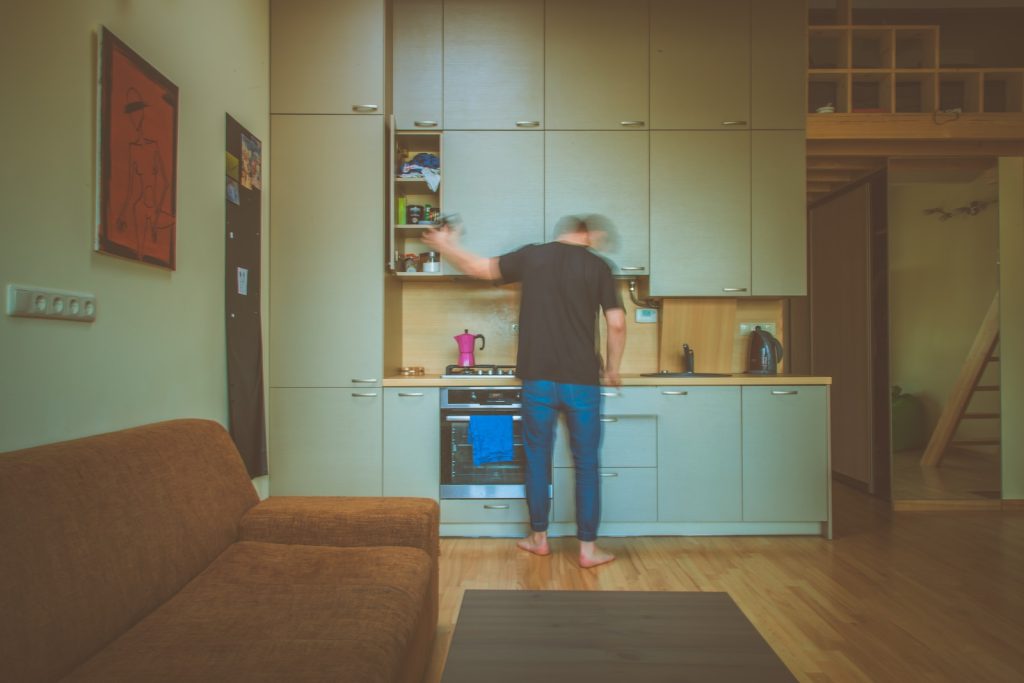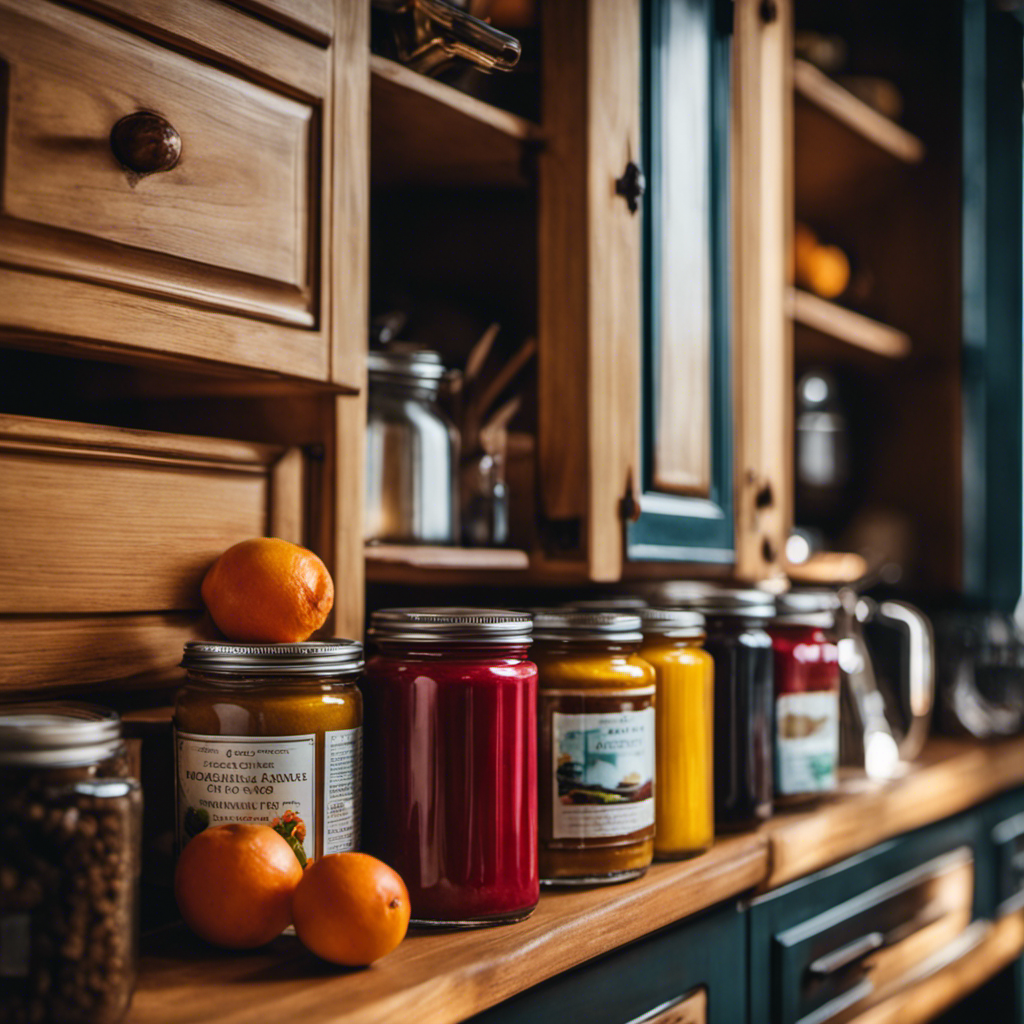Imagine walking into your kitchen and being greeted by beautifully painted kitchen cupboards that exude depth and character.
In this article, we will guide you through the art of achieving such stunning results.
From proper preparation to selecting the right paint colors, we will cover all the essential steps.
Discover techniques for creating texture and dimension, as well as choosing the right tools and materials.
With our expert advice, you'll be able to transform your kitchen cupboards into works of art.
Key Takeaways
- Proper preparation, including sanding, priming, and cleaning, is essential for achieving a smooth and professional finish in kitchen cupboard painting.
- Consider color psychology and the existing color scheme of your kitchen when selecting paint colors to create the desired atmosphere and complement the style.
- Experiment with various brushstroke techniques, brush sizes, and layering colors to add texture and depth to the painted cupboards.
- Use high-quality tools and materials, such as wood-specific primer, durable paints, and dense-bristled brushes, to ensure even application and a long-lasting result.
The Importance of Proper Preparation

You should always start your kitchen cupboard painting project with the proper preparation to ensure a smooth and professional finish. Before you even think about picking up a paintbrush, take the time to properly prepare the surfaces.
Begin by sanding the cupboard doors and frames to create a smooth and even surface. This will help the paint adhere better and prevent any imperfections from showing through. Use fine-grit sandpaper and work in the direction of the wood grain for the best results.
After sanding, it's important to apply a primer to the surfaces. Primer helps the paint adhere better and provides a smooth base for the color. Choose a primer that's specifically designed for kitchen cabinets and apply it evenly using a brush or roller.
Once the sanding and priming process is complete, you can move on to selecting the right paint colors for your kitchen cupboards.
Selecting the Right Paint Colors
Once you have narrowed down your options, it's time to compare and contrast different paint colors to find the perfect one for your kitchen cupboards. The right color combination can transform your kitchen and evoke different emotions.
Here are four tips to help you select the right paint colors for your cupboards:
-
Consider color psychology: Different colors have different effects on our mood and emotions. For example, warm colors like red and orange can create a cozy and inviting atmosphere, while cool colors like blue and green can promote a sense of calm and tranquility.
-
Look for inspiration: Browse through interior design magazines, websites, and social media platforms to find inspiration for color combinations that complement your kitchen's style and overall aesthetic.
-
Test it out: Before committing to a color, it's important to test it out in your kitchen. Paint small swatches on your cupboards and observe how the color looks in different lighting conditions throughout the day.
-
Consider the rest of your kitchen: Take into account the existing color scheme of your kitchen, including the countertops, backsplash, and flooring. Choose a paint color that complements these elements and creates a cohesive look.
Techniques for Creating Texture and Depth
To create texture and depth in your kitchen cupboards, you can employ various brushstroke techniques. By using different brush sizes and applying paint in varying directions, you can achieve a textured effect that adds visual interest to your cupboards.
Additionally, layering colors can also contribute to the overall texture, allowing for a more dynamic and multidimensional appearance.
Brushstroke Techniques for Depth
Try experimenting with various brushstroke techniques to add depth and texture to your kitchen cupboard painting. By incorporating these techniques, you can enhance the visual interest and create focal points in your kitchen.
Here are four brushstroke techniques that can help you achieve depth in your painting:
-
Cross-hatching: This technique involves using intersecting lines to create texture and depth. It adds a sense of movement and dimension to your painting.
-
Dry brushing: With this technique, you use a dry brush to apply paint in a light, feathery manner. This creates a subtle, textured effect that adds depth to your painting.
-
Impasto: Adding thick layers of paint with a palette knife creates a three-dimensional effect. It adds texture and depth, making your cupboards stand out.
-
Scumbling: This technique involves applying a thin, translucent layer of paint over a dry base. It creates a soft, diffused texture that adds depth and visual interest.
By mastering these brushstroke techniques, you can effectively enhance the depth and texture of your kitchen cupboard painting.
Transitioning into the next section, let's explore the art of layering colors for added texture.
Layering Colors for Texture
Have you ever considered how layering colors can create texture in your kitchen cupboard painting? By strategically applying multiple layers of paint in different shades and tones, you can achieve a distressed look that adds depth and character to your cupboards. One technique involves using stencils to create added texture. By placing a stencil on the cupboard surface and applying a slightly contrasting color over it, you can create a beautiful pattern that adds visual interest. Another method is to use a dry brush technique, where you lightly drag a dry brush over the surface to create a subtle texture. Lastly, consider using a glaze or antiquing medium to add depth and dimension to your cupboards. Experiment with different color combinations and techniques to create a truly unique and textured look.
| Techniques for Layering Colors | Benefits |
|---|---|
| Stenciling | Adds intricate patterns and texture |
| Dry Brushing | Creates a subtle and natural texture |
| Glazing | Adds depth and dimension to the paint |
Choosing the Right Tools and Materials
You'll need high-quality brushes and durable paints to ensure the longevity of your kitchen cupboard painting. Here are four essential tips to help you choose the right tools and materials for a successful project:
-
Choosing the right primer: A good primer is essential for achieving a smooth and flawless finish on your kitchen cupboards. Look for a primer specifically designed for painting on wood surfaces. It will help to seal the wood, prevent stains, and provide a smooth base for the paint.
-
Invest in high-quality brushes: Quality brushes will make a significant difference in the outcome of your project. Opt for brushes with dense bristles and a smooth finish to ensure even application of paint. This will minimize brush strokes and create a professional-looking finish.
-
Durable paints: Selecting durable paints is crucial for kitchen cupboards, as they're prone to wear and tear. Look for paints specifically formulated for high-traffic areas, such as kitchen cabinets. These paints are designed to resist chipping, scratching, and staining, ensuring your cupboards look great for years to come.
-
Consider the finish: Decide on the type of finish you want for your cupboards. Whether you prefer a matte, satin, or glossy finish, make sure to choose a paint that offers your desired look. Keep in mind that glossier finishes tend to be more durable and easier to clean.
Applying Layers for Dimensional Effects
Once you have chosen your base color, you can enhance the depth and dimension of your kitchen cupboards by applying additional layers of paint using a dry brush technique.
This technique involves using a small amount of paint on a dry brush, and then lightly sweeping it over the surface of the cupboards. By using a dry brush, you can create shadows and highlights that add depth to the overall appearance.
To achieve a more blended effect, you can also use blending techniques such as feathering or stippling. Feathering involves gently brushing the paint in a back-and-forth motion, while stippling involves dabbing the brush onto the surface.
These techniques allow you to create a layered and textured look that will make your kitchen cupboards stand out.
Finishing Touches and Sealants for Long-Lasting Results
To achieve long-lasting results for your kitchen cupboards, consider applying a high-quality sealant after adding the finishing touches. A sealant not only protects the paint from wear and tear but also adds a glossy sheen that enhances the overall look of your cupboards.
Here are four important steps to ensure the best results:
-
Choosing the right primer for kitchen cupboards: A primer creates a smooth surface for the paint to adhere to and prevents any stains or discoloration from bleeding through. Opt for a primer specifically designed for kitchen cabinets to ensure durability.
-
Properly clean your cupboards before painting: Remove all dirt, grease, and grime using a mild detergent and warm water. This step ensures that the paint adheres properly and prevents any imperfections on the surface.
-
Sand your cupboards for a smooth finish: Use a medium-grit sandpaper to gently sand the cupboards' surface, creating a rough texture that allows the paint to adhere better. Make sure to remove any dust or debris before applying the primer.
-
Apply the sealant for protection: Once you have painted your cupboards and they've dried completely, apply a high-quality sealant using a brush or roller. This step adds an extra layer of protection and enhances the longevity of your paint job.
Frequently Asked Questions
Can I Skip the Process of Proper Preparation and Still Achieve a Professional-Looking Result?
You may think skipping preparation will save time, but it's essential for achieving a professional-looking result. Proper preparation ensures a smooth surface, better adhesion, and longer-lasting finish. Don't underestimate its importance.
What Are Some Alternative Paint Colors That Can Be Used for Kitchen Cupboards?
If you're looking for alternative paint colors for your kitchen cupboards, there are plenty of options to consider. From bold blues to soft pastels, get creative with your cupboard painting techniques and make your kitchen pop!
Can I Achieve a Textured and Dimensional Effect Without Using Specific Techniques?
You can achieve a textured and dimensional effect on your kitchen cupboards without specific techniques. By using alternative paint colors and applying multiple layers with different tools, you can create depth and texture.
Is It Necessary to Invest in Expensive Tools and Materials for Cupboard Painting?
You don't need expensive tools and materials for cupboard painting. There are cost-effective alternatives like using good quality paint and brushes. Follow these tips to achieve a professional finish on a budget.
Are There Any Alternative Sealants That Can Be Used for Long-Lasting Results Instead of the Ones Mentioned in the Article?
Looking for alternative sealants for long-lasting results? While the article doesn't specifically mention them, there are options available. Consider weighing the pros and cons of different sealants to find the best fit for your project.
